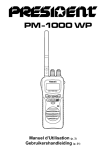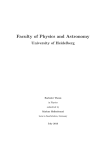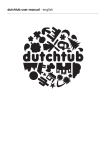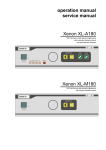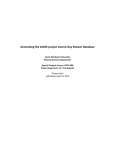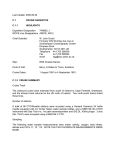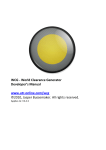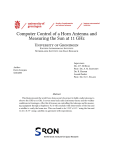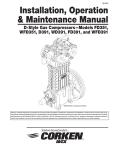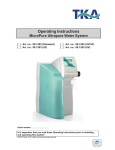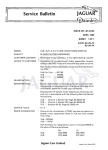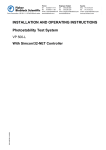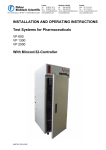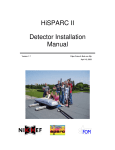Download A radio telescope for the detection of cosmic rays
Transcript
LORUN A radio telescope for the detection of cosmic rays Pim Schellart June 2006 Supervisors: prof. dr. J. Kuijpers and dipl. ing. Andreas Nigl Department of Astrophysics Report number: AF06B03 Abstract In the late 1960’s it was observed that radio pulses are emitted by cosmic ray air showers in the frequency range 2 − 520 MHz At the time it was not possible to study this phenomenon in detail due to technological restrictions. With the major advancements of computer technologies in the field of radio astronomy in recent years the study of radio emission from cosmic ray air showers became possible again. The new LOFAR1 radio telescope which is currently under construction in the Netherlands has the study of cosmic rays as one of its key projects. Already the LOFAR prototype station LOPES2 has proved to be able to detect the radio flashes coming from cosmic ray air showers with enough sensitivity for scientific study (as published in the Nature article Detection and imaging of atmospheric radio flashes from cosmic ray air showers[8]). LORUN which stands for LOFAR at the Radboud University Nijmegen is a project to build a radio telescope based on hardware designed for LOFAR by scientists and engineers at ASTRON. The result is a fully functional detector system with 4 quasi omnidirectional antennae for the detection of radio flashes from cosmic ray air showers by university and highschool students. 1 2 LOw Frequency ARray LOFAR PrototypE Station Acknowledgments I would like to thank ASTRON for providing us with the THETA3 antennae and hardware without which the project would not be possible. I would also like to thank them for helping solve various challenges we encountered along the way. For this I want to thank especially dr. M. de Vosc, ing. G. Schoonderbeekc and ing. H.J. Peppingc. I also want to thank my supervisors prof. dr. J.M.E. Kuijpersa and dipl. ing. A. Nigla for their help and giving me the opportunity of doing this project. Furthermore I want especially to mention the following people: dr. C.W.J.P. Timmermansb for providing me with information regarding the NAHSA detectors and helping with setting up the connection between the two systems. dr. A. Horneffera for having answered my many questions regarding the hard and software of both the LORUN and LOPES systems. ing. P.A.J. Dolrona and ing. C. Brouwerb for designing and building of many customized hardware components. And I want to thank the following people who all assisted in getting the LORUN project as far as it is today. prof. dr. H. Falckead, dr P.J. Groota, drs. S.J. Lafèbrea a Astronomy Department Radboud University Nijmegen b High Energy Physics Department Radboud University Nijmegen c ASTRON, 7990 AA Dwingeloo, The Netherlands d Max-Planck-Institut für Radioastronomie, 53121 Bonn, Germany 3 Ten Heterogeneous Element Test Array 1 Contents 1 The LORUN astronomy project 1.1 Goals . . . . . . . . . . . . . . . . . . . . . . . . . . . . . . . . . . 1.2 Planning . . . . . . . . . . . . . . . . . . . . . . . . . . . . . . . . 2 Introduction 2.1 Cosmic rays . . . . . . . . . . . . . . . 2.1.1 History . . . . . . . . . . . . . . 2.1.2 Sources . . . . . . . . . . . . . 2.1.3 The cosmic ray energy spectrum 2.2 Detection of cosmic rays . . . . . . . . 2.2.1 Particle detectors . . . . . . . . 2.2.2 Fluorescence detectors . . . . . 2.2.3 Air/Water Cherenkov detectors 2.2.4 Radio telescope detectors . . . . . . . . . . . . . 3 Single antenna 3.0.5 Assamble the antenna frame . . . 3.0.6 Connect the hardware . . . . . . 3.0.7 Install and configure the software 3.0.8 First data acquisition . . . . . . . 4 The LORUN system 4.1 Data detection with LORUN . . . . . 4.2 Hardware components . . . . . . . . 4.2.1 Antenna Structures & Layout 4.2.2 Dipole . . . . . . . . . . . . . 4.2.3 Low Noise Amplifier . . . . . 4.2.4 LORUN Rack . . . . . . . . . 4.2.5 Receiver Unit . . . . . . . . . 4.2.6 TIM Board . . . . . . . . . . 4.2.7 Slave Computer . . . . . . . . 4.2.8 Master Computer . . . . . . . 4.2.9 Clock Board . . . . . . . . . . 2 . . . . . . . . . . . . . . . . . . . . . . . . . . . . . . . . . . . . . . . . . . . . . . . . . . . . . . . . . . . . . . . . . . . . . . . . . . . . . . . . . . . . . . . . . . . . . . . . . . . . . . . . . . . . . . . . . . . . . . . . . . . . . . . . . . . . . . . . . . . . . . . . . . . . . . . . . . . . . . . . . . . . . . . . . . . . . . . . . . . . . . . . . . . . . . . . . . . . . . . . . . . . . . . . . . . . . . . . . . . . . . . . . . . . . . . . . . . . . . . . . . . . . . . . . . . . . . . . . . . . . . . . . . . . . . . . . . . . . . . . . . . . . . . . . . . . . . . . . . . . . . . . . . . . . . . . . . . . . . . . . . . . . . . . . . . . . . 4 4 4 . . . . . . . . . 5 5 5 6 7 7 7 10 11 11 . . . . 14 14 14 14 15 . . . . . . . . . . . 17 17 19 19 19 21 21 21 23 23 24 24 4.2.10 Trigger box . . . . . . . . . . . . . . 4.2.11 Power Supply . . . . . . . . . . . . . 4.3 Software tools . . . . . . . . . . . . . . . . . 4.3.1 Operating System & Kernel Modules 4.3.2 Directory Structure . . . . . . . . . . 4.3.3 Network Structure . . . . . . . . . . 4.3.4 lorundaq . . . . . . . . . . . . . . . . 4.3.5 Event Selection . . . . . . . . . . . . 4.3.6 LopesTools . . . . . . . . . . . . . . . . . . . . . . . . . . . . . . . . . . . . . . . . . . . . . . . . . . . . . . . . . . . . . . . . . . . . . . . . . . . . . . . . . . . . . . . . . . . . . . . . . . . . . . . . . . . . . . . . . . . . . . . . . . 5 Cosmic ray detections 25 25 25 25 26 26 27 28 29 31 6 RFI analysis and identification 6.0.7 Comparison with LOPES . . 6.0.8 Dynamic spectrum . . . . . . 6.0.9 Possible and identified sources 6.0.10 RFI suppression . . . . . . . . . . . . 35 35 36 36 41 7 Additional tasks 7.1 Documentation . . . . . . . . . . . . . . . . . . . . . . . . . . . . 7.2 Website . . . . . . . . . . . . . . . . . . . . . . . . . . . . . . . . 7.3 Lopesevent Tool . . . . . . . . . . . . . . . . . . . . . . . . . . . . 42 42 42 43 8 Summary & Outlook 8.0.1 Outlook . . . . . . . . . . . . . . . . . . . . . . . . . . . . 44 45 3 . . . . . . . . . . . . . . . . . . . . . . . . . . . . . . . . . . . . . . . . . . . . . . . . . . . . . . . . . . . . Chapter 1 The LORUN astronomy project 1.1 Goals The goals of this project are the following: • Build a fully functional detector system for cosmic rays based on hardware provided by ASTRON from the LOFAR test station THETA; • Gather first data and do a preliminary RFI1 analysis of the surrounding environment; • Build the system in such a way that it can be used as an outreach program to promote LOFAR to both university and high school students; 1.2 Planning This project is divided into the following work packages: • Study cosmic ray detection methods and general background. (chapter 2) • Assemble a single antenna structure with two dipoles and test manual data acquisition. (chapter 3) • Assemble the complete system with 4 antenna structures and 8 dipoles, automate data acquisition & event selection. (chapters 4 and 5) • Check for RFI and identify sources. (chapter 6) • Additional tasks, such as writing the LORUN website and documentation. (chapter 7) 1 Radio Frequency Interference 4 Chapter 2 Introduction 2.1 Cosmic rays Cosmic rays are γ-rays and particles mostly protons 87% and helium nuclei 12% wich continuously bombard the earths athmosphere from space1 . On impact with atoms in the earths atmosphere the higher energy (from about 1012 eV) particles initiate a chain of collisions and reactions creating an extensive air shower or EAS consisting of mostly electrons, positrons and photons 94%, muons 5%, protons, pions, neutrons, and atomic nuclei fragments 1%. 2.1.1 History Since the discovery of radio activity by Henri Becquerel and Marie and Pierre Curie in 1896 it was believed that the ionization of air in the atmosphere was caused by radiation from ground based radio active elements. Until the Austrian Victor Hess in 1912 conducted a series of high altitude experiments during a balloon flight. Using an electroscope which loses charge due to radiation he found that the amount of radiation increased approximately four fold over the rate at ground level. He concluded that the observed radiation must be radiation with a high penetrating power entering the atmosphere from above. For this discovery which he named ”Hohenstrahlung2 ” he was awarded the Nobel Prize in Physics in 1936. For many years following this discovery cosmic rays were presumed to be gamma rays3 with some electrons generated by Compton scattering. Until between 1927 and 1937 a large number of experiments showed that the primary cosmic rays are mostly positive charged particles. It was also shown that the secondary components observed at ground level are composed primarily of electrons, 1 Information mostly derived from wikipedia[7] Later renamed to cosmic rays by Robert Andrews Millikan 3 High energy photons 2 5 photons and penetrating muons. In 1948 observations with nuclear emulsions carried by balloons to near the top of the atmosphere showed that the primary cosmic-ray particles are mostly protons with some helium nuclei and a small fraction of heavier nuclei. In 1934 Bruno Rossi reported an observation of near-simultaneous discharges of two Geiger counters widely separated in a horizontal plane during an experiment to detect other phenomena. In his report he wrote: ...it seems that once in a while the recording equipment is struck by very extensive showers of particles, which causes coincidences between the counters, even placed at large distances from one another. Unfortunately, I did not have the time to study this phenomenon more closely. In 1937 Pierre Auger, unaware of Rossi’s earlier report, detected the same phenomenon and investigated it in more detail. He concluded that extensive particle showers are generated by high-energy primary cosmic-ray particles that interact with air nuclei high in the atmosphere, initiating a cascade of secondary interactions that ultimately yield a shower of electrons, photons, and muons that reach ground level. This is now called an Extensive Air Shower. 2.1.2 Sources There are roughly two kinds of cosmic rays. Solar cosmic rays originating from nuclear fusion processes in the sun and accelerated outwards due to interactions with the solar magnetic field. And extra solar cosmic rays originating from outside the solar system and possibly from outside the galaxy. Solar cosmic rays and extra solar cosmic rays can be separated by means of their energy and composition. The energy range of typical solar cosmic rays is between 10 keV and several MeV whereas the extra solar cosmic rays have energies reaching up as far as 1020 eV (ultra high energy cosmic rays with energies above 1018 eV are believed to be even extragalactic in origin). The elemental composition of solar cosmic rays is roughly the same as that of the sun itself. The extra solar cosmic rays also have a composition similar to that of the sun except for slightly lower Hydrogen and Helium concentrations, as well as a relative enhancement of heavy elements such as Lithium, Beryllium and Boron. These are probably the result of fission4 of heavier elements during their travel through the galaxy. There are many proposed acceleration sources for galactic cosmic rays. They can be accelerated by the same means as solar cosmic rays within other stars or for higher energies in neutron stars. Most are probably accelerated in the blast 4 A spontaneous (radio active decay) or stimulated (by collision) reaction whereby heavier elements split to generate lighter elements. 6 waves of supernova remnants. This does not mean that the supernova explosion itself gets the particles up to these speeds. The remnants of the explosions, expanding clouds of gas and magnetic fields, can last for thousands of years, and this is where cosmic rays are accelerated. Bouncing in the magnetic field of the remnant until reaching enough speed to break free and escape into the galaxy. But none of these sources can accelerate particles to the highest energies that have been detected. Suggested sources for this are active galactic nuclei, quasars or gamma ray bursters. More experiments are needed to find the answer to this question. 2.1.3 The cosmic ray energy spectrum The cosmic ray flux follows a power law as a function of energy: dN ∝ E −γ dE The index γ changes from ≈ 2.7 to ≈ 3.1 at about 5 · 1015 eV this is called the knee. There is also a flattening of the spectrum around 1019 eV called the ankle. Both these features are not well understood. A plot of the particle flux can be seen in figure 2.1. As can be seen in this plot at 1011 eV about 1 particle per square meter per second hits the earth. This decreases for 5 · 1015 eV to about 1 particle per square meter per year. Above 1019 eV only one particle per square kilometer per century hits the earth. Detecting these ultra high energy cosmic rays thus requires a large detector surface. 2.2 Detection of cosmic rays There are several methods of detecting cosmic rays. The primary particle can be detected directly for energies up to 1014 eV. This allows detailed analysis of the particles such as element and isotope determinations which may indicate it’s origin. For energies above this value the particle flux becomes so low that it is no longer economically feasible to detect particles this way. Ground based detectors must be used. There are several kinds of detectors the most common three being particle, fluorescence and air/water Cherenkov. A short overview of the principles behind them is given below. Also a description is given of the principles behind the new radio detection technique on which this experiment is based. 2.2.1 Particle detectors Particle detector setups usually consist of many (at least two but several hundreds are not uncommon) detectors combined in a detector array. Many different 7 Figure 2.1: Energy spectrum of cosmic ray flux [14]. The spectrum follows the power law dN ∝ E −γ . The index γ changes from ≈ 2.7 to ≈ 3.1 at about 5·1015 eV dE this is called the knee. The flattening of the spectrum around 1019 eV is called the ankle. 8 detector types are used one of which is the scintillator detector described below. A single detector generally works as follows. An incoming particle hits a piece of scintillating material exiting atoms within the material to higher energy states. These atoms return to their normal state under emission of a photon with a characteristic frequency determined by the properties of the material. This flash of light is then guided by a light guide to a photo multiplier tube. In the tube several plates are held at a high relative potential. The photon hits the first plate and releases an electron due to the photo-electric effect. This electron is accelerated by the electric field towards the second plate. When it hits the second plate it releases more electrons which are again accelerated to the next plate. After a few of these cycles enough electrons have been freed to generate a small electric current which is then detected5 . To ensure that the flash was indeed due to a cosmic ray this detection is then compared to another detector to see if there was a simultaneous event in both. If this is so the event is recorded as a cosmic ray and processed further. By comparison of the data from multiple detectors separated by a large distance the energy and direction of the primary particle can be determined. KASCADE-Grande KASCADE-Grande is an extensive air shower experiment array to study the cosmic ray primary composition and the hadronic interactions in the energy range E0 = 1016 − 1018 eV. The experiment is situated on site of the Forschungszentrum Karlsruhe. It measures simultaneously the electromagnetic, muonic and hadronic components of extensive air showers of cosmic rays. A scintillator array measures the electrons, photons and muons outside the core region of extensive air showers in 252 detector stations on a rectangular grid of 13 m spacing, hence forming an array of 200 × 200 m2 . In each station there are up to four electron/gamma-detectors and one muon-detector under a ironlead-absorber of about 20 attenuation lengths. The absorber serves as shielding against the electromagnetic component of an extensive air shower. Only muons with energies greater than 250 MeV are able to penetrate the absorber. The effective detection area per station is about 3.2 m2 for both detector types. The key component of the central detector is a finely segmented hadron calorimeter. A 20 × 16 m2 iron stack arranged in 9 horizontal layers of 11 nuclear interaction length is equipped with 10808 ionization chambers filled with Tetramethylsilane (TMS) or Tetramethylpentane (TMP) respectively working at room temperature. Each chamber has 4 readout electrodes, thus the energy release of hadrons is measured in more than 43000 electronic channels. Below 30 radiation length of absorber the central calorimeter contains a layer of 456 scintillation 5 The amplification factor is between 105 and 106 9 detectors acting as trigger for the calorimeter and measuring the arrival time of hadrons. Underneath the calorimeter two layers of multiwire proportional chambers measure muon tracks above an energy of 2 GeV with about 1.0o angular accuracy. A muon tracking detector is located north of the KASCADE-Grande central detector. In a 50 m long tunnel muons above an energy threshold of 0.8 GeV are measured with streamer tubes. On an active area of 128 m2 muons are tracked with an accuracy of 0.5o . The Grande array has been realized by means of 37 stations at a mutual distance of about 130 m covering an area of 0.5 km2 next to the KASCADE site in order to operate jointly with the KASCADE detector components. Each KASCADE-Grande array station is equipped with 10 m2 of scintillation counters and the electronic components to generate a trigger signal and for calibration purposes. A central data acquisition station (DAQ) collects the data from all stations and generates a valid experiment trigger. The KASCADE-piccolo trigger array consists of an array of 8 stations. Each equipped with 10 m2 of plastic scintillator. It is placed towards the center of the Grande array. The main aim of piccolo is to provide an external trigger to Grande and to KASCADE for coincidence events. HiSPARC & NAHSA HiSPARC which stands for High School Project on Astrophysics Research with Cosmics is a cosmic ray detector based on scintillator detectors. Based in the Netherlands it is build by Universities and highschool students as a series of 10 clusters spread out over the country. Currently over 30 stations are taking data and expansion of the project is well underway. NAHSA (Nijmegen Area High School Array) is one of the clusters of HiSPARC and consists of 5 particle detector stations each consisting of 2 detectors placed in skiboxes on top of schools. The trigger signal produced by the NAHSA detector at the roof of the Radboud University is used for triggering LORUN events. 2.2.2 Fluorescence detectors The same process which takes place in scintillator material also takes place in the atmosphere itself. Molecules and atoms in the air are exited to higher energy states by collisions with EAS particles. These molecules and atoms subsequently drop back to there original state emitting a photon in the process. This photon can then be detected using sensitive telescopes. This technique has the advantage that the path of an EAS can be traced directly. It is however difficult to do in practice mainly due to high background noise (environmental light). 10 2.2.3 Air/Water Cherenkov detectors When a charged particle moves trough a transparent medium at a speed higher then the speed of light in that medium it emits electromagnetic radiation. This radiation is called Cherenkov radiation and is dominant in high density materials. When the medium is air the radiation is called Air Cherenkov radiation. This radiation can also be detected using sensitive telescopes. For Water Cherenkov he principle is the same as that of the Air Cherenkov technique. Only here the medium is water (mostly stored in closed, dark tanks) and the light flashes are detected by photo multiplier tubes6 . 2.2.4 Radio telescope detectors As extensive air showers consist mainly of charged particles they also emit electromagnetic radiation. This radiation is produced by two different mechanisms: The Askaryan effect describes a phenomenon whereby a particle travelling faster than the speed of light in a dense radiotransparent medium such as salt, ice or the lunar regolith produces a shower of secondary charged particles which contain a charge anisotropy and thus emits a cone of coherent radiation in the radio or microwave part of the electromagnetic spectrum. This phenomenon is of primary interest in using bulk matter to detect ultrahigh energy neutrinos. The effect is named after its postulator, physicist Gurgen Askaryan (1928-1997). Geo-synchrotron Radiation When a charged particle is accelerated by the earths magnetic field it emits electromagnetic radiation. Because the physical extent of an extensive air shower is smaller than the wavelength at radio frequencies coherent radiation is emitted. Measurements have shown that this mechanism dominates in the radiation from EAS; Several experiments try to detect this radiation and use it as an extension for existing cosmic-ray detector arrays. LORUN is such an experiment. LOFAR LOFAR is an acronym of the LOw Frequency ARray a large radio telescope currently under construction in the Netherlands7 . LOFAR uses phased arrays of quasi omni directional antenna with the aperture synthesis technique developed in the 1950s. It will operate in the frequency range 10 − 240 MHz and will use 6 Water Cherenkov detectors are also particle detectors and as such are mostly used in an array. The air Cherenkov technique on the other hand mostly uses one telescope to look in the direction of the incoming air shower. 7 Specifications derived from LOFAR Phase I Baseline Specification[10] 11 newly developed techniques both hardware and software to filter out the dominant Radio Frequency Interference or RFI. The electronic signals from the LOFAR antennas are digitized, transported to a central digital processor, and combined in software in order to map the sky. The cost is dominated by the cost of electronics and will follow Moore’s law, becoming cheaper with time and allowing increasingly large telescopes to be built. So LOFAR is an IT-telescope. The antennas are simple in design but there are a lot of them 25000 in the full LOFAR design. To make radio pictures of the sky with adequate sharpness, these antennas are to be arranged in clusters that are spread out over an area of ultimately 350 km in diameter. (In phase 1 that is currently funded 15000 antenna’s and maximum baselines of 100 km will be built). Data transport requirements are in the range of many TB/s8 which will be provided by a large glass fiber network, and the processing power needed is about 27 Tera − FLOPS the processing power is provided by a dedicated IBM Blue Gene L supercomputer situated at the University of Groningen. This computer will also have 1 PB of storage space for storing data from various observations before offline processing. The mission of LOFAR is to survey the universe at radio frequencies from ∼ 10 − 240 MHz with greater resolution and greater sensitivity than previous surveys. LOFAR will focus on the following 4 key projects9 : The Epoch of Reionisation LOFAR can search for the signature produced by the reionization of neutral hydrogen. This crucial phase change is predicted to occur at the epoch the formation of the first stars and galaxies, marking the end of the so-called “dark ages”. The redshift at which reionization is believed to occur will shift the 1420 MHz line of neutral hydrogen into the LOFAR observing window. Deep Extragalactic Surveys LOFAR will detect the most distant massive galaxies and will study the processes by which the earliest structures in the Universe (galaxies, clusters and active nuclei) form and probe the intergalactic gas. Transient Sources LOFAR’s large instantaneous beam will make it uniquely suited to efficiently monitor a large fraction of the sky, allowing a sensitive unbiased survey of radio transients for the first time. Averaging of the data will provide information on a variety of time scales, ranging from seconds to many days. The resolution attained will be sufficient for the crucial task of rapid optical and X-ray identifications. Observation targets include Gamma-Ray Bursts and Galactic Black-Hole/Neutron-Star Systems as well as Exo-planets and Pulsars. 8 9 Based on total data flow, Individual data rates are in Giga bit range. Information obtained from The LOFAR website[3] 12 Ultra High Energy Cosmic Rays The main focus of this project. LOFAR will detect radio emission from cosmic ray air showers. THETA THETA is an acronym for Ten Heterogeneous Element Test Array. It was a test station for LOFAR consisting of ten inverted V shaped antenna in 10 structures10 coupled by a combination of standard PC hardware and dedicated components. Originally developed by ASTRON for testing LOFAR hardware it’s antenna and hardware are now part of the LORUN project. ITS In December 2003 LOFAR’s Initial Test Station (ITS) became operational; this was an important milestone in the LOFAR development. The ITS system consists of 60 inverse V-shaped dipoles11 each dipole is connected to a low noise amplifier (LNA), which provides enough amplification of the incoming signals to transport them over a 110 m log coaxial cable to the receiver unit (RCU). LOPES LOPES is the LOFAR PrototypE Station. It is designed to demonstrate the feasibility of cosmic ray radio detection. And to test the hardware technologies of the LOFAR telescope. In the first phase until 2003, LOPES consisted of ten dipole antennas. This has been expanded to a total number of 30 antennas as of summer 2005. These antennas are read out digitally and are connected to a central computer. Here, the data from the antennas is correlated by software, so that the antennas together essentially form a phased array. The software can point the array by forming a virtual beam and is also able to adaptively suppress interference from other sources, such as radio and TV stations. The test array was first set up at the MPIfR in Bonn to check the hardware and develop the software. Afterwards it has been installed at the KASCADE experiment in Karlsruhe. This is a running and well calibrated air shower experiment, which provides LOPES with a suitable trigger and reconstructed shower parameters. These parameters act as a starting point for LOPES and will be used to calibrate its results. 10 THETA did single polarization measurements, LORUN uses the same hardware in less structures for observing in two polarization planes. 11 Since summer 2005 converted to 30 dual antenna structures. 13 Chapter 3 Single antenna The work package in assambling the LORUN detector consists of assembling a single antenna and testing the hard and software. This package has been completed with the following points: 1. Assemble the antenna frame. 2. Connect the hardware. 3. Install and configure the software. 4. First data acquisition. The following subsections describe these points in more detail. 3.0.5 Assamble the antenna frame The antenna was placed on top of the roof of the university. First the plastic structure was put together. Then the cables connecting the LNAs to the power supplies and the receiver boxes where laid out. 3.0.6 Connect the hardware The hardware for the LORUN antenna was set up in the RIF1 control room. We organized the correct power supplies for the different voltages needed by the hardware and constructed two sub-d connector cables for the power supply of the receiver boxes. A protection circuit for correct and safe power supply for the clockboard was constructed by ing P.Dolron. 3.0.7 Install and configure the software We use the program tim2file for getting large datasets. adapted, compiled and installed. 1 Radio Interferometer 14 This program was Figure 3.1: Time domain voltage plot of first successful data for a single polarization plane / antenna dipole. The x-axis shows the time in micro seconds. The y-axis shows the value from the ADC since there is no absolute calibration of the antenna yet this can not be converted directly into electric field strength. The oscillating feature in the data is due to the 62.25 MHz signal from a nearby TV transmitter. 3.0.8 First data acquisition When reviewing the first data it was evident that there was a strong source of interference. After further analysis with which we had help from ing. H.J.A.Pepping and ing. G.Schoonderbeek from ASTRON it was determined to be external interference. Moving the antenna to a different location on the roof reduced the interference to be able to detect air showers above 1017 eV primary particle energy (We still have to use 6 db suppression on the incoming signal to keep it within the dynamic range of the AD converter). A time domain voltage plot of each antenna polarization plane can be seen in figure 3.1 and a plot of the spectral power density for the same data in figure 3.2 15 Figure 3.2: Spectral power density plot of first successful data for a single polarization plane / antenna dipole. The x-axis shows the frequency in MHz, and the y-axis shows the corresponding Fourier coefficient (again no absolute calibration so the numbers are relative). 16 Chapter 4 The LORUN system This chapter describes the complete LORUN system. First a general description of the detection process is given followed by a more detailed description of the various hard and software components. 4.1 Data detection with LORUN When the radio signal produced by a cosmic ray air shower hits the dipole antenna’s in a antenna structure an electric signal is produced. This signal is then amplified by a Low Noise Amplifier and sent trough a coaxial cable of 50 meters to the lab. In this lab the signal first enters a Receiver Unit. Inside this receiver unit the signal is again amplified and passes trough a band pass filter. Then it is sampled by a Analog Digital Converter and this digitized signal is fed into a High Speed Link, this component converts the digital electric signal to a series of light pulses which travels along an optical fiber to a High Speed Link receiver. This receiver is situated on a TIM board which is connected via a standard PCI interface to the LORUN slave computer. The High Speed Link receiver transforms this light signal back to an electric one and feeds it into the TIM board where the signal is continuously written into a standard RAM buffer of 1GB. This process stores up to 6.7 second of data in each RAM module which is continuously refreshed. There are 8 dipoles in total (2 perpendicular in each of the 4 antenna structures) and each of them follows the same track through a separate set of components. There are two slave computers, each of them contains two TIM boards. Each TIM board contains 2 High Speed Link receivers and two memory modules. Parallel to this process the NAHSA particle detector also receives the air shower and upon reception produces a trigger signal before storing its data on a separate system. This trigger signal is passed to the LORUN system via the clock board component (described later) and upon receiving the trigger signal the TIM boards continue to write a specified number of data samples before freezing 17 Figure 4.1: Schematic picture of the LORUN data acquisition system. Please keep in mind this picture is only for a single antenna. the receiving process and transferring the data from the TIM boards to the slave computers RAM memory. This data from all antenna is then send via a standard ethernet link to a single master computer where they are combined in a single file called an eventfile and stored on a hard drive. Subsequently the TIM boards are reset and continue to write data until the next trigger signal is received. A schematic picture of the detection process can be found in figure 4.1. This process generates about a 1000 eventfiles each day. Most of these eventfiles do not contain actual air shower data (but are caused by particles triggering a single detector station and are thus either local radiation or hardware static). And those that do contain air shower data have to be separated from the Radio Frequency Interference and hardware noise which is present in any detector system. To eliminate events triggered by local radiation and hardware static the following procedure is followed. At the end of each day a list is retrieved from the NAHSA system containing the timestamps of those events where two or more stations were hit simultaneously. Eventfiles with the same timestamp (up to a second difference) are moved to a different location on the hard drive for further manual checking. After a week the remaining unmatched eventfiles are rechecked and those that do not match the timestamps are deleted. 18 Figure 4.2: A LORUN antenna structure 4.2 4.2.1 Hardware components Antenna Structures & Layout The antenna structures are made of PVC and are pyramid shaped (see figure 4.2). Each of the ribs of the pyramid contains a dipole antenna wire. The 4 antenna structures are placed on top of the University B faculty roof in a parallelogram shape (to obtain different baselines) as shown in figure 4.3 The exact positions of the antenna structures have been measured with a differential GPS system to enable beamforming.1 4.2.2 Dipole Each antenna structure contains two perpendicular dipole antenna which are nothing more than two strings of standard copper wire at a length of 1.0 m designed to resonate at a frequency of 71 MHz. Because of the triangular placement of the dipoles the antenna is able to receive signals from multiple locations between zenith and 45o . And by means of the two perpendicular antenna one quarter of a sphere is covered and differences in polarization of the incoming radiation can be measured. 1 The mathematical procedure of combining data from different antenna to look in a specified direction 19 Figure 4.3: Layout of the antennas on the university roof 20 4.2.3 Low Noise Amplifier Inside the container at the top of the pyramid structure the Low Noise Amplifier or LNA is situated. This component amplifies the signal with a gain between2 14.4 dB at 80 MHz and 18.5 dB at 44 MHz. It also changes the impedance to 50 Ω to match that of the coaxial cable. The amplifier is a negative feedback amplifier, with the input impedance of the feedback network matched to the impedance of the radiator. This provides sensitivity over a wide frequency range with good linearity and noise performance. 4.2.4 LORUN Rack A metal rack is used to store the LORUN hardware3 in a safe, shock proof environment. An image of this rack can be seen in figure 4.4. In this rack are the following components: 1. LORUN slave computers; 2. Power distribution spider; 3. Receiver Units (RCUs); 4. Clockboard box; 5. Power supply; 4.2.5 Receiver Unit The receiver unit or RCU is located in the LORUN rack. This box consists of the following components: Box with connectors A aluminum box with standard sub-D connectors for the power and SMA connectors for the signal and the clock signal. On the back of the box there is a glass fiber connector for the digital data. Amplifier The amplifier is a standard commercial amplifier with a gain of 19 dB. Because of the low amplitude of the signal and the high noise level of the galactic radiation a special amplifier is not required. 2 3 These are laboratory values as the effective gain depends on the impedance it sees as input Excluding the LORUN master computer and the antennae. 21 Figure 4.4: The LORUN rack 22 Band pass filter The filter used to suppress all signal with frequencies outside the main sensitivity range of the antenna has a range of 43 − 76 MHz and a stop band suppression of 60 dB Analog Digital Converter Board The Analog Digital Converter is a 12 bit ADC which samples at 80 MHz. It has a nominal dynamic range of 20 · log(212 ) = 72 dB. Its effective number of bits is 9.5 this results in an effective dynamic range of 20 · log(29.5 ) = 57 dB. High Speed Link transmitter The High Speed Link (or HSL) transmitter sits on top of the ADC-Board. It receives the 12 bit, 80 MHz signal and first converts it (with the help of an external clock signal) to 24 bit at 40 MHz. This signal is then serialized and send trough a fiber optic to the corresponding receiver unit on the TIM Board. It also encodes the clock signal into the data signal to check the synchronization at the receiving end. This component needs by far the most power (3.3 V, 0.9 A) and thus requires extra space for cooling which is provided by stacking the RCUs with 1 cm space on all sides. 4.2.6 TIM Board TIM stand for Twin Input Memory. This board is connected to the PC via a standard PCI-connector. It has two inputs which can receive the signal from the HSL receiver4 at 1.2 GBit/s. Each module has 2 GB RAM and can store up to 6.7 s of data5 . The modules can operate in two modes: 1. Begin writing at a sync signal until the memory buffer is full. 2. Write continuously and stop at a predefined time after the sync signal is received. We always use the second mode, which allows to read out everything before and a defined period after the trigger. 4.2.7 Slave Computer The two slave computers are standard PCs with the following specifications: 4 5 The HSL receiver is located on top of the TIM Board Or a total of 2 · 6.7 = 13.4 s in serial mode, with one input used to fill the memory. 23 Figure 4.5: The clockboard controlling synchronization of all components CPU Cache Memory Harddrive 4.2.8 Intel(R) Pentium(R) 4 CPU 3.06GHz 512 KB 512 MB 40 GB Master Computer The master computer is a standard PC with the following specifications: CPU Cache Memory Harddrive 4.2.9 Intel(R) Pentium(R) 4 CPU 3.00GHz 1024 KB 1 GB 200 GB Clock Board To synchronize all components and distribute the trigger signal a clock board is used (see figure 4.5). This clockboard contains a low noise, high stability crystal clock which provides a 80 MHz signal which is then distributed by coax cables to the RCAs. The clock signal is also halved (to 40 MHz) and sent trough equal length coax cables to the TIM Boards. 24 4.2.10 Trigger box The trigger box is a component specially designed6 . for LORUN. Located along with the clock board inside the clock board box it has two functions: • Convert trigger signal provided by NAHSA to input singal for LORUN clock board; • Allow manual triggering via the parallel port of the LORUN master computer (used for testing purposes and taking full 7 s datasets); 4.2.11 Power Supply To provide power for all components of the system (except router, PCs and TIM Boards) a power supply was custom built to our specifications by ing. Cees Brouwer. This power supply provides the following voltages (DC) to the components directly: V 3.3 15.0 A 1.5 1.5 Color Live Color Ground blue black red black Application Clockboard LNA And it provides the following voltages (DC) via the power distribution spider to the RCUs: V 3.3 5.0 15.0 4.3 A 8.0 3.0 1.5 Color Live Color Ground blue black red black yellow black Application HSL ADC-Board Amplifier Software tools The LORUN system is mainly a digital system and as such a lot of software is used in it’s operation. In the next few sections I will outline it’s main components. 4.3.1 Operating System & Kernel Modules All LORUN computers use the Linux operating system. This is done because of it’s stability, low latency, low cost of ownership and most importantly the ability to adapt all parts of the OS specifically for this system. 6 Designed and build by ing. Peter Dolron on specifications by Andreas Nigl and Pim Schel- lart 25 Figure 4.6: LORUN master computer directory structure for data storage. The LORUN master computer runs SuSE Linux 9.2 with the linux-2.6.8 kernel. The LORUN slave computers both run SuSE Linux 8.2 with the linux-2.4.20 kernel and a specially written7 kernel module for the TIM Board hardware. For performance reasons the ReiserFS filesystem is used on all computers, ReiserFS greatly outperforms both ext2 and ext3 when working with large numbers of relatively small files. 4.3.2 Directory Structure All eventfiles are stored on the LORUN master computer. The directory structure of this system can be seen in figure 4.6 4.3.3 Network Structure All LORUN computers are connected to each other (and to the NAHSA computer) via a dedicated 100 Mbit switch. They are all in the astro.kun.nl domain, and are named as follows: • lorunmaster (LORUN master computer and data storage) • lorun0 (slave computer controlling antenna 0 and 1) 7 Kernel modules have been written for the THETA system by technicians at ASTRON and are used by us for LORUN 26 • lorun1 (slave computer controlling antenna 2 and 3) 4.3.4 lorundaq This is the main component of the LORUN data acquisition software. It consists of two parts: • A glish script lorundaq using AIPS++ and running on the LORUN master computer; • A C program timclient running on each LORUN slave computer; The LORUN software is based on the LOPES tools package, originally developed for the LOPES radio telescope. This package depends heavily on the Astronomical Information Processing System AIPS++. For connecting the various components together the Glish scripting language is used. From the AIPS++ website[6]: Glish is a scripting language which, together with the C++ library, makes it very easy to develop distributed, loosely coupled, applications. The C++ library implements a ”software bus” which allows applications to easily be distributed across a heterogeneous network. The scripting language itself is a vector oriented calculator with language constructs designed for control of asynchronous events. It allows the user to control and connect processes attached to the ”software bus”. Glish is currently used primarily for data analysis and telescope control. It is a cornerstone of the data analysis system called AIPS++. This system uses Glish for control and communication. The compute tasks are written in C++ and connected to the interpreter via the ”software bus”. Glish is also the command line interface for AIPS++, and from it, users can combine computing elements to fit their needs. In addition, most simple graphical user interface (GUI) elements are implemented using a Tk addition to Glish. This addition allows users to control the GUI and the application within the same event-oriented scripting language. The lorundaq script is started on the LORUN master computer and first connects (via ssh) to the LORUN slave computers. On these computers it starts the timclient program. This program initializes the TIM Boards and the TIM Boards start taking in data. When a trigger signal is generated the TIM Boards continue taking in data for 215 samples = 0.4 ms and then freeze, they then send a signal to the timclient which informs the lorundaq script that an event is incoming. The timclient reads the dataset from the timboard 216 samples = 0.8 ms around the trigger signal and sends it via the glish bus to the lorundaq script. After receiving datasets from all antenna the lorundaq script calls another C program 27 eventsaveclient which combines the datasets with a file header and writes them to disk in a single eventfile. 4.3.5 Event Selection As mentioned before the data detection generates about a 1000 eventfiles per day most of which do not contain actual cosmic ray air shower data. A set of specially written bash scripts performs the selection of relevant events. The scripts are executed in a chain in which each script calls the next after completion. The first script is executed by the systems cron daemon each night. The scripts are as follows (in the correct sequence): selectionscript.sh This script first creates a directory for matched event files of the previous day. It then downloads a file from the NASHA computer containing timestamps for all events of the previous day that had a hit in more then one particle detector station. It then checks all eventfiles in the incoming directory4.6 of the LORUN master computer for matches (within 1 second). If found it moves these events to the newly created eventfile directory. After all files have been checked it sources the next script in the chain. current.sh This script is used to save all eventfiles (those not matched) for a week in an organized manner to enable later rechecks in case a particle detector was mailfunctioning. It generates a subdirectory inside the current directory4.6 for the previous day and subdirectories for each hour. It then moves all eventfiles of the previous day to their respective directories (based on timestamps). Then it sources the next link in the chain. statistics.sh This script generates some statistics which it writes to a logfile. Mainly the number of matched triggers by comparing the number of matched timestamps. After completion it sources the next link in the chain. timestamps.sh This script generates a zipped text file containing all event timestamps for the previous day (for checking correct operation of the selection procedure). Then it sources the next link in the chain. clean.sh This script first runs an other script selectionscript recheck.sh which rechecks all files in the current directory for the 8th previous day. Then the clean.sh script deletes all files of the 8th day thus keeping 7 days of data on the machine. It then sources the final link in the chain. backup.sh This script uses the rsync tool to synchronize the eventfile directory to an external backup system8 . 8 Currently the ray server is used which has 6TB of storage space and is also used for processing the LOPES and ITS data 28 Figure 4.7: LopesTools graphical user interface with LORUN eventfile loaded. 4.3.6 LopesTools When the eventfiles have been selected it leaves about 10 events per day. These have to be checked by hand. For this purpose the LopesTools package is used. This package was originally developed for the LOPES radio telescope and also uses the AIPS++ system. It has a graphical user interface (see figure 4.7 for a screenshot) and a glish backend. It has many functions but we primarily use the following: • Display time domain voltage of the antenna signal; • Display total power of the antenna signal; • Fourier transform the signal and display spectral power density; • Flag frequency ranges to zero and inverse Fourier transform to reduce RFI; The event files are first loaded in this program and are then Fourier transformed. To reduce RFI of known frequencies these are flagged to zero and the sample is 29 inverse Fourier transformed. Then the total power is displayed and we look for a non repeating peak around our hardware delay of −100 µs in multiple antennae. If one is found a log entry is made and the next event is checked. 30 Chapter 5 Cosmic ray detections There have been 3 confirmed cosmic ray detections with the LORUN detector so far as well as a number of unconfirmed candidates. The first detection is a cosmic ray with 17.2 eV primary particle energy (as computed by NAHSA software). The flash was detected in both of the crossed dipole antenna as can be seen in figure 5.1. The peak height of each event depends on the energy of the primary particle and the angle between it’s trajectory and the geomagnetic field. The second detection was with two1 different aligned dipoles spaced by 32 m. The primary particle energy as calculated by NAHSA software is 17.4 eV This event is especially interesting because the direction of the incoming particle projected on the surface has been calculated to be almost directly along the line connecting the two antenna2 with an angle of 28o of zenith. This matches the time difference of ≈ 140 ns in the LORUN data. A plot of this event together with a rough picture of the antenna positions can be seen in figure 5.2 The third detection was with two crossed dipoles in a single antenna structure and a third dipole in a different antenna structure spaced by 32 m. The primary particle energy as calculated by NAHSA software is 17.3 eV. A plot of this event can be seen in figure 5.3 1 2 The other antennae were not operational at the time Direction calculated by NAHSA 31 Figure 5.1: Cosmic ray detection with LORUN, 17.2 eV primary particle energy. Peaks have been shifted to 0 to compare shapes and radio peak height. [12] 32 Figure 5.2: Cosmic ray detection with LORUN, 17.4 eV primary particle energy. The plot also shows the relative positions of the LORUN and NAHSA detectors. [12] 33 Figure 5.3: Cosmic ray detection with LORUN, 17.3 eV primary particle energy. Peaks have been shifted to 0 to compare shapes and radio peak height. The green and blue curves represent the signal from two parallel dipole antennae spaced by 32 m. The red curve represents the signal from a perpendicular dipole antenna located in the same structure as the dipole of the green curve. [12] 34 Chapter 6 RFI analysis and identification The frequency range used by the LORUN system (40 − 80 MHz) is dominated by Radio Frequency Interference or RFI. To keep the signal within the dynamic range of the ADC a 6 dB attenuator is connected between the LNA and the Receiver Unit. As a first measure to reduce RFI a band pass filter1 is used to suppress all signal with frequencies outside the main sensitivity range of the antenna, it has a range of 43 − 76 MHz and a stop band suppression of 60 dB. After that software tools can be used such as Fourier transforming the signal and suppressing all signal from RFI sources at a known frequency. This is helped by the fact that cosmic ray air showers generate a broad spectrum and are not influenced much by the suppression of narrow band interference. 6.0.7 Comparison with LOPES As a first step to check wether the location would be suitable for a detector station we took a simple spectrum. It was evident that the RFI was stronger then at the LOPES location. A comparison between our spectral power plot and that of LOPES (see figure 6.1) shows a comparable spectrum. The ADC counts (figure 6.2) and ADC power (figure 6.3) comparison plots show a similar pattern as well, with the exception that ours is a factor 10 higher in magnitude2 . This was expected however and since the power remains within the dynamic range of the ADC software tools can still be applied to suppress it. 1 As an anti aliasing filter it’s primary function is to prevent signal from outside the frequency range of the ADC to reach the ADC. This would also be necessary if there was no RFI pressent and just the cosmic ray signal was measured. However suppression of RFI also occurs and therefore it is mentioned here. 2 Please keep in mind that there is still 6 db suppression in the LORUN signal. 35 Figure 6.1: Comparison between LORUN and LOPES spectral power density (LORUN = red and LOPES = green) [11, A.Nigl], [12] 6.0.8 Dynamic spectrum To better chart our RFI environment a dynamic spectrum was taken. All events for a period of 12 h are Fourier transformed and their coefficiënts are plot against time. The plot can be seen in figure 6.4. Horizontal lines in this plot represent continuous sources of RFI. Vertical lines are short time pulses either RFI or cosmic rays. 6.0.9 Possible and identified sources The peak a 62.25 MHz which can be seen in figure 3.2 and figure 6.1 is a TV transmitter in channel 1 band 4 which is located in Lopik and transmits Nederland 1. Other possible sources can be seen in table 6.1. While most of the frequencies in this table are out of the range of our system3 saturation of the Low Noise Amplifier can occur. This may cause intermodulation of the signals which brings signals from outside the band to within detection range. As this is expected to happen for frequencies up to ≈ 160 MHz only these are listed in table 6.1. 3 Outside the band pass filter limits and the main sensitivity range of the antenna/LNA. 36 Figure 6.2: Comparison between LORUN and LOPES ADC counts (LORUN = red and LOPES = green). [11, A.Nigl], [12] 37 Figure 6.3: Comparison between LORUN and LOPES ADC power (LORUN = red and LOPES = green). Block averaged data to better see the main structure. [11, A.Nigl], [12] 38 Figure 6.4: LORUN dynamic spectrum. All triggered events for a period of 12 h. The x-axis shows the time and the y-axis the Fourier coefficiënts. Horizontal lines represent continuous sources of RFI. Vertical lines are short time pulses either RFI or cosmic rays. 39 Table 6.1: Possible RFI sources within Nijmegen up to ≈ 160 MHz Frequency MHz 73.28 78.3375 81.28 86.7375 107.8 145.15 145.75 149.7625 149.7625 150.2875 150.6875 150.6875 150.7125 151.4375 151.4375 151.4375 151.6125 152.3375 152.3375 152.3625 152.5375 152.9125 153.8375 154.0125 154.2625 154.8875 155.2875 156.25 156.6 158.39 158.91 159.25 159.57 159.57 159.65 160.47 160.85 Source KMAR transmitter Lobith brigade Police Channel Region Gelderland-South transmitter KMAR transmitter Lobith brigade Police Channel Region Gelderland-South transmitter Local Station Incoming frequency Relay station PI3NYM R6 Outgoing frequency Relay station PI3NYM R6 TaxiCentral Citax rental car and taxi service Power company channel 6M public Glass trade Seuren Stumenberg B.F.I. Containerservice/cleaning Busservice Markus De Grundt V. Draaien garage Taxi Citax Senioralarm Medicom/Spitcom channel Foundation animal ambulance Doctor service Cleaning service Seceur Advice company for safety Fire department mobile channel 2 Fire department mobile channel 4 Police mobile channel City Guard Power company channel 6H Public Public transportation channel 4 City bus CVD Marifoon 05 M Rijkswaterstaat Marifoon 12 S Harbor service Ooy Traintaxi Power compay channel 19M Wille BV private company Luisman Pinball machines private company Newspaper de Gelderlander Boesewinkel road construction Marifoon 05 H Rijkswaterstaat 40 6.0.10 RFI suppression Suppression of the RFI to get a better signal to noise ratio for cosmic ray radio signals can be done in multiple ways. Hardware based These options may be applied before or during detection. • The LNA/antenna setup may be changed to have less sensitivity outside it’s normal operating band; • Band pass filters can be used to further suppress signal at high RFI frequency ranges; • Once specific frequencies have been identified as RFI notch filters can be used to suppress them; Software based These options may be applied after detection. • If the direction of the incoming cosmic ray is known (by for instance scintillator detector measurements) the mathematical procedure of beamforming can be applied. This process combines data from different antenna in such a way that the result is the same as physically pointing the antenna in a specified direction. Thereby the RFI coming from other directions is suppressed; • If the frequencies of RFI sources are identified one can easily Fourier transform the signal, flag these frequencies to zero and perform an inverse transformation. Thereby obtaining the original signal minus the undesired frequencies. Currently only the band pass filter and Fourier transformation techniques are used in the LORUN system. Implementation of the other techniques will further improve sensitivity in the future. 41 Chapter 7 Additional tasks 7.1 Documentation As one of the primary goals of this projects is to enable other university and possibly highschool students to use the system and its data several manuals have been written: LORUN instruction and outreach manual Provides the general outline for outreach talks. LORUN technical manual Technical documentation of the system including all the scripts and programs. LORUN user manual Documentation for checking eventfiles. 7.2 Website For this project to fulfill its goal of being usable by other students I have also written a project website[1]. This site contains all information about the LORUN project including: • The LORUN documentation (as described in the previous section); • Photos of the detector and it’s hardware; • PDF versions of all presentations about the project; • The source code of all LORUN programs and scripts written by me; • An event log which allows a user to see online which events have been checked by whom and if there was an air shower identified; The last point is especially interesting. It consists of three parts: 42 • A C++ program called eventlog on the lorunmaster computer. This program allows a user who has checked an event to make a log entry of this with a single command. The user enters the command eventlog [filename] [candidate air shower yes/no] [user] [comment] And the program automatically generates a standard XML1 file containing the current date and the specified information. This is stored on lorunmaster in a temporary location. • A shell script on the webserver which is executed by a cron job every night and automatically merges the new XML file with the existing one on the webserver. • A XSL2 stylesheet which converts the XML file to a table (ordered by filename and thus the event date) for online viewing. 7.3 Lopesevent Tool As an additional project I have written (together with Jaap Kroes) a program which allows a user to access LOPES style event files3 from the command line on a UNIX/Linux system. This program is called lopesevent and it has the following functions: • Reads and writes both file and channel headers; • Reads channel data for all or a number of specified channels; And the following specifications: • Written in C++ • Licensed under the GNU General Public License; • Uses standard GNU commandline structure including command abbreviations (flags) and the ability to specify options in random order; • Uses the LopesEvent C++ class originally written by Sven Lafèbre. This class has been extended to allow writing to new and existing files by Jaap Kroes and myself, and these improvements have been contributed to the LOPES software package. 1 eXtensible Markup Language eXtensible Stylesheet Language 3 The same file structure is used by the LOPES and LORUN radio telescopes. 2 43 Chapter 8 Summary & Outlook Within the scope of this report we have built the LORUN system. A radio telescope based on hardware from the LOFAR test station THETA donated to this project by ASTRON. This system uses new technologies both in software and hardware to detect radio emission from cosmic ray air showers. This radiation first discovered in the 1960’s is emitted by charged particles moving trough the geomagnetic field of the earth by the mechanism of synchrotron radiation. The particles themselves are originating from nuclear reactions in the sun and other galactic or even extra galactic sources. They can have energies as high as 1020 eV. While the lower energy cosmic rays are mostly accelerated by magnetic fields of stars or supernovae, the mechanism which controls the acceleration of the highest energy cosmic rays is yet unknown. LORUN is built along side the existing cosmic ray detection system NAHSA. NAHSA uses scintillator plates to directly detect air shower particles. It has been build by a collaboration of the Radboud University and several high schools in the Nijmegen area. Combination of the two experiments has several advantages. First it provides the LORUN system with an independent trigger signal. Furthermore it enables scientists and students to combine data from both experiments, this provides further insight into the studied air shower because the radio signal is integrated over the whole shower and not just the end products. The latter is even more usefull with LORUN as it features detection capabilities in two perpendicular polarization directions. First a single antenna system was constructed and manual triggering was tested. A challenge at this stage was to correctly and safely provide power to all components. For this and for the manual triggering a protection cirquit was developed. The software was installed and a first data set was taken. The data showed saturation due to high Radio Frequency Interference originating from the nearby Erasmus building. The antenna was moved to a new location where it was shielded from this radiation source and the new data showed a spectrum comparable to that at the location of the LOPES detector. After this success the complete data acquisition system was build. The system 44 consists of 4 antenna structures with two perpendicular dipole antennae. The signal received by the dipoles is first amplified and then sent trough coaxial cables to receiver units located inside the University building. Inside these receiver units the signal from one antenna is again amplified and sent trough a band pass filter. This filter suppresses all signal of frequency outside the antenna sensitivity range of 40 − 80 MHz. The signal is digitized and transmitted via fiber optic cables to one of the two LORUN slave computers. Here it is received and written into memory banks located on a dedicated PCI card. The Receiver Units and PCI boards are synchronized by means of a clock signal provided by a separate clock board. This clock board also receives and distributes the external NAHSA trigger signal. Once the trigger is received via the clock board by the PCI boards the data is frozen and transmitted via ethernet to a single LORUN master computer. Here the data is combined into single event files which are written to disk. At the end of each day scripts are automatically executed by the LORUN master system. These scripts select possible cosmic ray candidates based on data provided by NAHSA and stores them in a separate directory. Software tools can later be used to manually check these events. Three events have been confirmed as cosmic ray detections. The first event was recorded in a single antenna structure by both perpendicular dipoles. It has an estimated primary particle energy of 17.2 eV. The next event was recorded by two distinct antennae. The estimated primary particle energy is 17.4 eV. The time delay between the detections in the two antenna matches the air shower direction provided by NAHSA. The third event was recorded by three antennae located in two distinct antenna structures. The estimated primary particle energy is 17.3 eV. The frequency range used by the LORUN detector is dominated by Radio Frequency Interference or RFI. To reduce this interference and improve the signal to noise ratio of our detector several mechanisms are used. As a first step a hardware band pass filter suppresses signal of frequencies outside our band. After the signal is detected and stored a Fourier transform (and inverse Fourier transform) may be applied, this allows the frequency components of known RFI sources to be flagged out. These procedures reduce the RFI far enough for the detection of air showers. With at least three successfull cosmic ray detections the LORUN system has demonstrated it’s ability to overcome a high RFI environment. Furthermore all requirements such as automation and documentation have been met to enable other university or high school students to use the system and it’s scientific data. 8.0.1 Outlook The LORUN system has now been moved to the new Huygens building of the Radboud University Nijmegen. This was necessary as the old building will be dismantled in the nearby future. This new location is in direct line of sight with 45 the Erasmus building. On top of the Erasmus building a number of strong radio transmitters are present. These transmitters deliver enough power in frequencies outside our band1 to saturate the first amplifier in our detection system. This causes intermodulation of the signal which brings components of the interference within our sensitivity range thereby also saturating the Digital Annalog Converter and rendering software RFI reduction impossible. This challenge will be solved by modifying the amplifier to include a band pass filter. Additional components such as notch filters will further suppress known RFI sources. This will result in a system with even higher signal to noise ratio than the original setup on the old building, bringing air showers with lower primary particle energies within detection range. In the future measuring the exact positions of the antennae using GPS will enable beamforming. This mathematical procedure can then be used on the data to look in the direction of the air shower further improving the signal. Also the system may be calibrated to find the relation between the electric field strength, the direction of the air shower and the ADC counts for each antenna. Another challenge for future projects is determining the nature of the feature in our data2 that can be seen in the right bottom channel on figure 4.7. This shows a difference in power between before and after the trigger signal. It occurs in all antennae but not in all data sets and is always at the same position. A satisfactory explanation for this has not yet been found3 Implementation of a cosmic ray pipeline will enable fully automatic selection of cosmic ray detections. In the future this may even be linked to the internet allowing students and high school students to request data of specified periods to be studied on line. These improvements can be used as the basis of new astronomy projects for other astronomy students. With this LORUN provides the University not only with a new radio telescope but also with a unique system to introduce students to the next generation of radio astronomy. . . 1 This has been measured by an external antenna system It also occurs in data from LOPES. 3 One possible explanation could be that old data from the previous event is ’glued’ to the new data at this point as a result of a hardware or software error. 2 46 List of Tables 6.1 Possible RFI sources within Nijmegen . . . . . . . . . . . . . . . . 47 40 List of Figures 2.1 Energy spectrum of cosmic ray flux . . . . . . . . . . . . . . . . . 8 3.1 3.2 Time domain voltage plot of first successful data . . . . . . . . . . Spectral power density plot of first successful data . . . . . . . . . 15 16 4.1 4.2 4.3 4.4 4.5 4.6 4.7 Schematic picture of the LORUN data acquisition system . . . . . A LORUN antenna structure . . . . . . . . . . . . . . . . . . . . Layout of the antennas on the university roof . . . . . . . . . . . The LORUN rack . . . . . . . . . . . . . . . . . . . . . . . . . . . The clockboard controlling synchronization of all components . . LORUN master computer directory structure for data storage . . LopesTools graphical user interface with LORUN eventfile loaded 18 19 20 22 24 26 29 5.1 5.2 5.3 Cosmic ray detection with LORUN, event 1 . . . . . . . . . . . . Cosmic ray detection with LORUN, event 2 . . . . . . . . . . . . Cosmic ray detection with LORUN, event 3 . . . . . . . . . . . . 32 33 34 6.1 6.2 6.3 6.4 Comparison between LORUN and Comparison between LORUN and Comparison between LORUN and LORUN Dynamic Spectrum . . . 36 37 38 39 48 LOPES spectral power LOPES ADC counts . LOPES ADC power . . . . . . . . . . . . . . density . . . . . . . . . . . . . . . Bibliography [1] LORUN Website, http://www.astro.ru.nl/lorun/ [2] NAHSA Website, http://www.hef.ru.nl/nahsa/ [3] Dutch LOFAR Website, http://www.lofar.nl [4] LOPES Website, http://www.astro.ru.nl/lopes/ [5] Lopestools Website, http://www.astron.nl/~bahren/research/coding/ [6] AIPS++ Website, http://aips2.nrao.edu [7] Wikipedia, http://www.wikipedia.org [8] Detection and imaging of atmospheric radio flashes from cosmic ray air showers, Falcke H. et al. 2005, Nature 435, 313-316 [9] Radio Emission from Cosmic Ray Air Showers, Huege, T. 2004, Rheinische Friedrich-Wilhelms-Universität Bonn [10] LOFAR Phase I Baseline Specification, Marco de Vos, 2004-09-26, ASTRON [11] Plots provided by dipl. ing. A. Nigl [12] An Outreach Project for LOFAR and Cosmic Ray Detection, Nigl, A., Timmermans, C., Schellart, P., Kuijpers, J., Falcke, H., Horneffer, A., de Vos, C. M., Koopman, Y., Pepping, H. J., Schoonderbeek, G., 29th icrc proc., 16, 341, 2005 [13] Sterrenkundestages in Nijmegen, http://www.astro.ru.nl/nl/educ_best/stagesnijm_dut.html [14] Chicos Caltech Website cosmic ray spectrum, http://www.chicos.caltech.edu/collaboration/education/spectrum.html [15] Measuring Radio Emission from Cosmic Ray Air Showers with a Digital Radio Telescope, Horneffer, A. 2006, Rheinische Friedrich-Wilhelms-Universität Bonn 49




















































